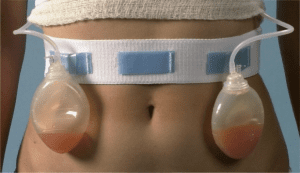Yearly, millions of women and men in the United States return home from the hospital, with one or more drains inserted in the surgical site. The drains are placed during certain surgeries to carry fluids away from the surgical site, a process that helps with healing. A drain may need to stay in place for several days to several weeks. Unfortunately, traditional ways to secure these drains, such as use of safety pins, have significant drawbacks, such as tube punctures, which can frustrate patients.
After years of working with patients, and witnessing their frustration, discomfort, and anxieties with post-surgical drains, as well as the clinical complications that occurred related to not having a universal way to secure drainage bulbs, I decided it was time to find a safer, easier to use, alternative. Despite an extensive search, I could not find one, so I developed a belt-like surgical drainage bulb holder. Patients can wear the holder under clothing, while sleeping, and in the shower.
The Surgical Drainage Bulb Holder (SDBH), patented in 2003, meets the clinical criteria for maximizing drain function and preventing complications, and is used in 155 nationally recognized hospitals.
Filling a need
Traditionally, most drainage bulbs have been secured with safety pins, to hospital gowns and clothing when home. Some drains come with a plastic clip, which is ineffective as it easily slips off clothing as the bulb becomes weighted with drainage, and is not secure. There are camisoles for mastectomy patients, which support a prosthesis and also have pockets for drain bulbs. Camisoles are effective as a prosthetic garment after the incisions are healed, but not effective for securing drain bulbs immediately post-op due to incisional discomfort. Camisole drain pockets have a lot of movement, and when the bulbs are weighted with drainage, can cause discomfort at the drain insertion site, especially in bed at night. Safety pins, clips, and camisoles do not allow a patient with drains to shower. Patients often resort to makeshift methods in order to shower with drains.
Using safety pins to secure drains can result in serious problems. Pin sticks are possible, painful, and can occur in staff and patients, or the drain itself. Any skin puncture is a potential site of infection, and in the hospital can be considered a sharps exposure requiring testing to identify blood borne diseases; testing is costly for hospitals and patients. A pin stick in the drain tube or bulb causes loss of suction, rendering the drain ineffective.
As a home health nurse, I’ve spent many hours teaching patients and their families drain management. In addition to emptying and recording drainage, and re-activating the suction, they are instructed how and where to secure the bulbs to prevent pulling, leaking, and possibly dislodging the drain. Patients are taught that drainage amounts are used by the surgeon, to determine when to discontinue the drains.
There are obstacles for patients coming home with drains, which can interfere with their ability to perform drain care. The normal anxiety of coming home after surgery can be increased by the additional burden of managing drains. The patient, or a family member, needs to perform drain care that has been performed by professionals in the hospital. Patients are usually in pain, tired, and possibly dealing with a cancer diagnosis. They wonder how to perform the routine activities of using the bathroom, sleeping, or taking a shower with drains.
Initially, when home, patients often don’t recall where to secure the bulbs. They can experience pulling that causes pain at the insertion site, or it can result in dislodgement. Drainage can leak, accidents can occur if a patient rolls onto a drainage bulb in bed causing leaks, and soiling bed linens or the mattress. Some patients reported fear of leakage accidents that kept them from sleeping in their beds.They chose to sleep in a recliner chair the entire time they had drains.
About the holder


The SDBH is a soft, non-latex, adjustable fabric that can secure up to four drainage bulbs without the use of safety pins. Each drain bulb is individually secured with Velcro-type fasteners, so there is virtually no movement of the drainage bulb or tubing. The individual securement decreases patient discomfort and prevents pulling or accidental dislodgement of the drainage tube. When positioned below the surgical site, the holder decreases the potential for leaking. It allows for easy visibility when determining the need to empty the bulbs, and can be worn independent of clothing during the day, in bed at night, or in the shower. It is universal in size and gender.
The SDBH can be put on the patient in the OR, under a hospital gown, worn home from the hospital, and throughout the days or weeks the drains need to remain in place.
An SDBH Kit helps the patient transition from the hospital or surgery center to the home setting. It contains all the needed components for drain care: two measuring cups, a drainage record sheet which includes patient education and step-by step instructions, and two drain belts, one is for showering, if the physician permits.
The abdominal binder, with individual fasteners, also secures up to four drains, eliminating the need for safety pins. Latex free, it has a paneled elastic construction with a plush back and a hook and loop closure. It can conform to body shape, making it comfortable to wear.
Response to the SDBH continues to be positive with patients saying it is comfortable and that they feel it secures the drain well.
Mary Robinson Prody, an experienced home care nurse, lives in Minnesota, where she operates Promedics Products (https://promedicsproducts.com).
Selected reference
Lynn PB. Caring for a Jackson-Pratt drain. In: Lynn PB, Ed. Taylor’s Handbook of Clinical Nursing Skills. 2nd ed. Baltimore, MD: Wolters Kluwers; 2014:chap 50.



















12 Comments.
As a nurse, and author of this article, I wanted to weigh in on the use of safety pins noted in the previous post. Although this patient came up with another way to secure drain bulbs (have to admit my husband helped me out with what a Koozie is!) we very much discourage the use of safety pins. They can cause pin sticks in the patient, or the drain (which has happened!) which causes loss of suction and renders the drain ineffective. Appreciating all the comments, many continue to describe make-shift methods to secure drains, which is why the Drainage Bulb Holder-now known as the Drainage Bulb Holder II with improved easy grip fasteners, was developed. It is my wish and goal that patients should not have to be working at finding methods to manage their drains while dealing with so many other issues! Still today, I continue to hear of multiple make-shift methods which often includes safety pins. Although many make-shift options suffice, they are not optimal for the individual securement of each drain bulb with the fasteners on the Drainage Bulb Holder II, which not only addresses comfort, but decreases complications and improves outcomes. The Drainage Bulb Holder II snugly secures each drain as it becomes weighted with drainage. It is worn under clothing, so not visible to others, but easily visible to the patient to see when to empty the drain bulbs. It is intended to be worn below the insertion site of the drain tubes to promote maximum drain function with no leaking at the insertion site. That snug securement provides a good night sleep, and then a safe shower-if allowed. In that case 2 belts are required, one for showering and one for dry use. If able to shower it does come in Kit form with 2 belts, 2 measuring cups and a Drainage Output Record Sheet with drain care instructions and patient education. Many Hospitals are using the Drainage Bulb Holder now, but not enough, as I continue to see and hear of patients struggles with their drains! My best advice is to speak to your providers before surgery so there is a definitive plan for your post-op drains.
Ii had bilateral masectomy with DIEP reconstruction, so I have 4 drains. I found it easier to use 4 separate koozies attached to my clothing . Secure the koozie with large safety pins to the clothing where it ont bind or tug on you. The koozie is softly padded and can be secured outside the clothing . For the lower clothing, I have found wearing men s cotton boxer undergarment 1-2 sizes larger than my own underwear. The tubing can be threaded through the “flap” opening and then gently placed in the koozie. Boxer shorts enabled my leg openings to not be binding yet provided adequate coverage. The high waist line did not rub or irritate any of my stitches. Placing 2″ square of gauze around the tube entrance where the stitches are, enabled me to control any tugging at the sites. ( until my allergy to surgical tape became an issue.) Fortunately , the sites are sufficiently healed to enable me to go without any badges or taping.
In response to the previous post, glad to hear you found a way to manage your drains, just wanted to weigh in as nurse we very much discourage the use of safety pins! And why the Drainage Bulb Holder II was developed by a nurse. Safety pins can cause pin sticks in you or the drain itself (and it has happened!) which causes loss of suction rendering the drain ineffective. I honestly didn’t know what a Koozie was, but my husband helped me with that one. So the Drainage Bulb Holder II allows individual securement of each drain bulb, independent of clothing-no need to pin to different articles of clothing or no threading of tubing, and when not in a pocket/Koozie it is easily visible to see the drainage and need to empty. The Drainage Bulb Holder II with the individual fasteners secures the bulbs, as they become weighted with drainage during the day, in bed at night, and in the shower-if allowed. In that case you would need 2 belts-one for showering which dries in just a few hours, and one for dry use. It does come in Kit form which includes 2 belts, all the needed components for drain care including measuring cups and a Drainage Output Record Sheet to record the drainage. Aside from the safety pin issue, it seems like you needed to find your own make-shift method for drain management, and that is why the Drainage Bulb Holder II was developed to have patients avoid such work on your part, when you already have so much on your plate!
My husband just had surgery in the Atlanta, GA area. I was in occupational health administration my last 20 years. He came home with a JP bulb drain. We were told to use a safety pin to secure drain to hospital gown or clothes. I was surprised we were not given a drain holder or another device other than a safety pin to secure drain. Surely since my younger hospital and home health jobs there should have been a drain holder device developed. Before I googled to research a device, I made our own holder with a roll of gauze. I told my husband if I can not find a device, I will develop one. Great work – glad a nurse developed a practical device. I do not know why all hospitals do not supply this device or something similar. Thank you
After 9 breast surgeries I have learned that the most important thing for drain comfort is to secure the drain tube at the insertion site by using a 2×2 split sponge under the tube, a 2×2 gauze on top and tape the whole thing down with a strip of 4″ wide Tegaderm, bought in a roll. These supplies are available on Amazon. I have contact allergies to adhesives, but I can tolerate Tegaderm pretty well. Stabilizing the drain tube in the wound is essential. The dressing also soaks up leakage. I have the belt described above, and it has been helpful when I had 4 drains. When I had 2 drains, I used a mastectomy camisole. I also recommend a kangaroo terry cloth belt with pockets for showering with mutliple drains. For 2 drains I use a amoena lanyard with a clip that goes through the bulb loop and clips back on the lanyard ribbon.
I used this belt and also tried the apron, lanyard and shirt pockets. The belt is superior because it doesn’t allow drains to move. Great job! Thank you!
How can I secure a JP drain that’s on my buttock and where does the drain need to hang? I’m having trouble getting it lower than the entry site.
We here at our hospital are looking to buy the Drain Belts where would I get them?
That “belt” is just another annoying, tight thing around your body, when you already have enough bandages to itch. I think my solution is much better and doesn’t require anything but your own clothing. I have four drains; two on each side. I discovered that putting a pair of drains into each pants pockets (left and right side) works wonderfully. While I can still feel the tubing on my skin, neither the tubes nor anything else is secured to my body. The tubes are long enough that I can lower my pants to use the toilet without removing them from my pants pockets. No safety pins, no belts, no Velcro, nothing binding. My method also prevents a weird bulge at my waistline and allow my shirts to fit better.
Would this work for other drains as well?
While we don’t use the drain belt, we do use a “cath secure” that is placed on the existing dressing to prevent more adhesive being placed on the patient skin. The strap on the cath secure fits perfectly through the drain loop, preventing the need for safety pins. This technique is used on our large abdominal surgery patients.
Way to go! We would love to have you make and appearance in our nursing fundamentals lab sometime at Rasmussen College School of Nursing- St.Cloud, MN